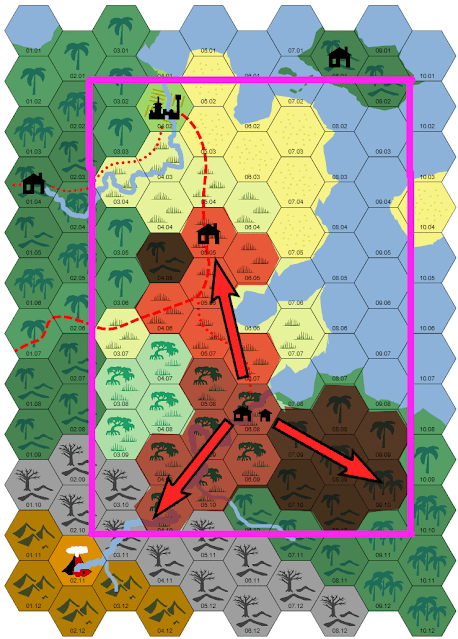In this series of articles, I will guide you through the process of designing a sandbox hexcrawl, using Chardauka, one of the continents in my world, as a case study. Throughout these articles, we’ll tackle both adventure content creation to fill the hexes and the worldbuilding elements that bring the setting to life.
As I mentioned in another article, the first step in designing your hexcrawl is to have a hex map. If you’re looking for tips on how to create one, you can check out my advice in the article Drawing a Hexmap. Once we have the initial draft of our hex map, the next step is to decide on your players’ base of operations.
For my Chardaukan hexcrawl, I’ve chosen the city of Garampur for this purpose. This decision aligns with my interest in deepening the lore of its culture and its strategic location near the center of the hex map, granting players greater freedom to decide which region to explore. I chose a scale of 1 hex = 12 miles, imagining that traveling on foot from Garampur to the nearest village, Palenka, to the northwest, would take about two days. This scale emphasizes that we’re working with a fairly expansive area.
My intention is to give players an initial hook—a vector leading them toward iconic adventures that serve as starting points for the first sessions. These key points are akin to "my Bleak Falls Barrow in Skyrim" or "my Moathouse in Hommlet". This approach helps me prioritize content preparation for my sessions and focus on areas the players are likely to explore in the early stages.
 |
The destination hexes indicated by vectors were chosen arbitrarily and will be refined later. Players will need to cross several hexes to reach these destinations, creating opportunities to encounter other locations and adventures along the way. Additionally, I’ve decided not to give players reasons to venture into more dangerous areas, such as the Flaming Jungle or the Sacred Volcanoes, until they gain more experience. If necessary, the inhospitable climate of the Flaming Jungle will act as a natural barrier to prevent access to these high-challenge regions.
Since Garampur will be the first location players see and their base of operations, it requires detailed development. Situated in a swampy area, Garampur belongs to the Blazing Pact, a confederation of fire-aligned races who can drink sulfurous water without harm. Built on stilts to adapt to seasonal flooding, the city’s design is inspired by Indian architecture. Its inhabitants navigate by boat and use movable walkways as often as they walk on the perpetually soft, muddy streets. Garampur is also notable as one of the few seaports of the Blazing Pact, promoting trade and cultural exchange. A prominent temple dedicated to Sulayra, the goddess of geysers, springs, and merchants, underscores her importance as the city’s main deity.
In the Sulfurous Marsh, I plan to include several key elements to enhance the region’s immersion:
- A sulfur-contaminated river originating from a volcano in the southwest, creating a unique habitat for species adapted to its toxicity. In the northwest, mangroves and rainfall purify the waters, creating a stark contrast in the flora and fauna.
- Tribes of firenewts, guiding travelers through the marsh, in conflict with green-scaled lizardfolk tribes and bullywugs in more remote areas.
- Traces of battles between the Chardaukans and demonic invaders summoned by a radical faction of the Blazing Pact, visible in scattered ancient fortresses and arsenals.
- Ruins from a pre-cataclysmic era, where aquatic empires once enslaved primitive races using mind-control monoliths.
To enrich the region you’re working on with ideas and references, I
recommend exploring commercial campaign settings and adventures that
could complement your work. It’s natural to draw inspiration and adapt
others’ creations to enhance your own project. For instance, at Adventure Lookup, a platform supported by none other than Matt Colville you can search for modules based on creature types or biomes, accessing more material than you’ll likely ever need.
In
future articles, I’ll share the references I’ve decided to use and
provide examples of how to adapt commercial modules to enrich a hexcrawl
with unique stories and challenges.


Comments
Post a Comment